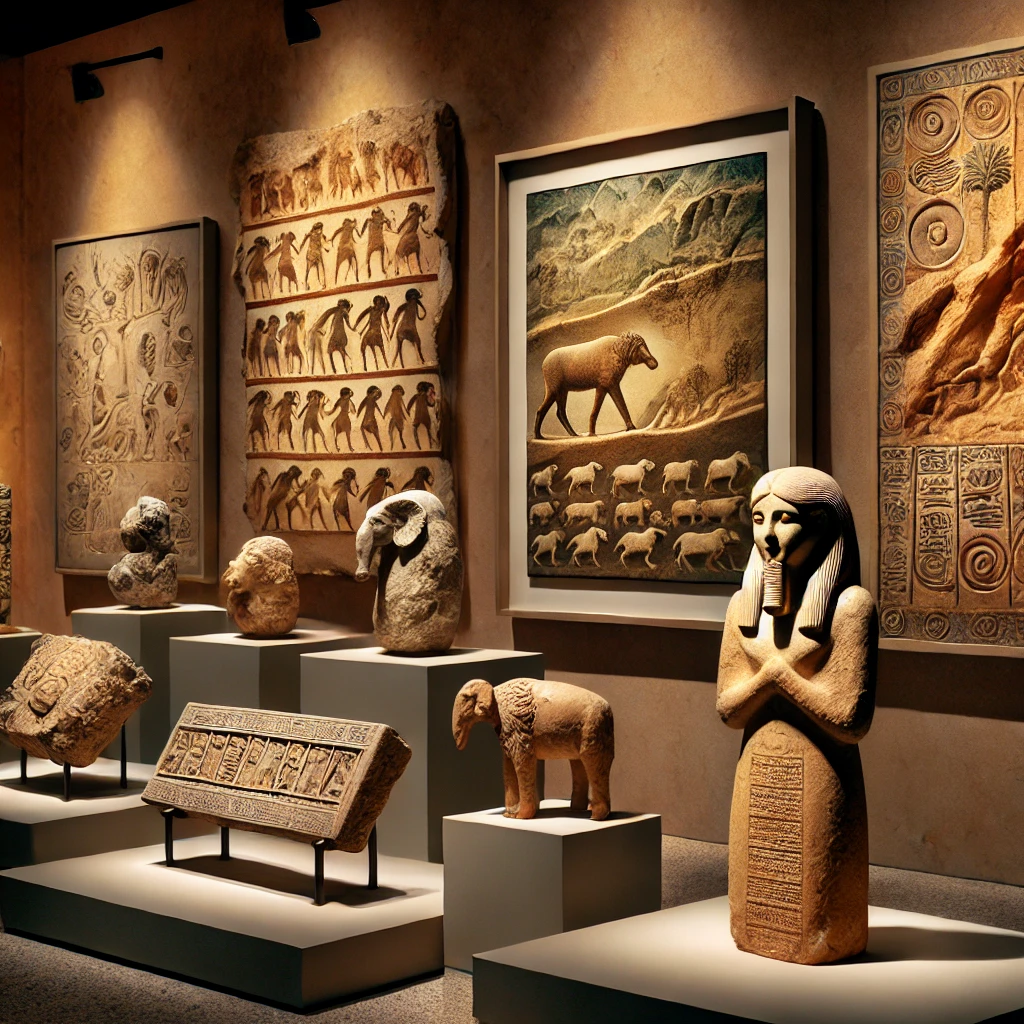Ancient Artz
Ancient art holds a distinct charm, illuminating the cultures, beliefs, and values of early civilizations. Spanning from prehistoric cave paintings to the intricately carved sculptures of ancient Greece, each artwork reveals how human creativity evolved through the millennia. Ancient art serves as a historical record of early societies, and although some pieces may be mysterious or enigmatic, they communicate a wealth of information about the past. This article explores key facets of ancient art, including its origins, unique characteristics, cultural significance, and the prominent ancient artz forms that continue to captivate modern audiences.
Origins of Ancient Art
The story of ancient art begins in the depths of prehistory, when humans first started expressing themselves visually. Archaeologists have discovered some of the oldest known artworks in regions where early humans are believed to have lived, such as Africa and Europe.
- Prehistoric Art (Paleolithic Period): The earliest art forms date back to the Paleolithic era, around 40,000 years ago, when humans began creating figurines, carvings, and cave paintings. These works, typically made with natural pigments like ochre, charcoal, and clay, depict animals, hunting scenes, and abstract symbols. The cave paintings in Lascaux, France, for example, showcase the artistry and technical skill of prehistoric artists and offer insights into their daily lives and beliefs.
- Neolithic Advancements: As societies transitioned from hunting and gathering to agriculture during the Neolithic period (circa 10,000–4,500 BCE), art began to evolve, reflecting new societal structures. This period saw the creation of pottery, weaving, and more complex sculptures, signifying a shift toward more permanent settlements and community-based lifestyles. Neolithic art often features geometric designs and stylized figures, suggesting that early humans were developing a sense of aesthetics and symbolism.
The Cultural Significance of Ancient Art
Art in ancient times was not merely decorative; it played a vital role in religious rituals, political propaganda, and social hierarchy. Ancient art offers valuable insight into how early cultures understood the world around them and sought to influence it.
- Religion and Spirituality: Many ancient artworks were created to honor deities, spirits, or ancestors. Egyptian, Mesopotamian, and Mesoamerican civilizations, for example, created statues and monuments to represent gods and goddesses. Ancient temples and sacred sites were often adorned with elaborate carvings, illustrating a strong belief in the divine and an attempt to connect with the supernatural.
- Political Authority and Propaganda: Art also served as a tool for rulers to showcase their power and legitimacy. Pharaohs in ancient Egypt commissioned grand statues and monuments as symbols of their divine rule. The Roman Empire used sculptures and coins bearing the likenesses of emperors to remind people of their leaders’ authority. Similarly, in ancient Mesopotamia, kings like Hammurabi used carved reliefs to proclaim their laws and achievements.
- Social Status and Identity: Art was often a marker of social status. In many ancient societies, only the elite could afford to commission elaborate artworks. Jewelry, pottery, and textiles were crafted with unique designs that indicated the wearer’s social class or community identity. Art also played a significant role in burial practices, where elaborate tombs and burial objects were believed to accompany the deceased into the afterlife, as seen in the tombs of Egyptian pharaohs.
Distinctive Styles and Forms of Ancient Art
Ancient art encompasses a wide range of styles and mediums, each reflecting the values and technological capabilities of its time. Below are some of the most influential ancient art styles that left a lasting impact on art history.
- Egyptian Art: Renowned for its monumental architecture, intricate hieroglyphics, and stylized figures, Egyptian art is immediately recognizable. It often depicted gods, pharaohs, and the afterlife in a distinct, two-dimensional style where the size of figures indicated social status. Egyptian artisans used bright colors, symmetrical designs, and strict proportions, resulting in iconic works such as the Sphinx, the Great Pyramids, and the statues of Ramses II.
- Mesopotamian Art: In ancient Mesopotamia, art often depicted religious and mythological themes. Stone reliefs and cylinder seals portrayed gods, mythical creatures, and the daily life of the people. The Mesopotamian ziggurats, stepped pyramids that served as temples, are notable architectural feats that combined both religious and artistic symbolism.
- Greek Art: Greek art is characterized by its emphasis on humanism, proportion, and realism. Greek sculptors like Phidias and Polykleitos created lifelike statues that celebrated the beauty of the human form, exemplified in works like the Venus de Milo and the Parthenon sculptures. Greek pottery, too, featured black-figure and red-figure techniques depicting scenes from mythology and daily life. This focus on realism and idealism heavily influenced later Western art traditions.
- Mesoamerican Art: Civilizations like the Maya, Aztec, and Olmec left behind impressive artifacts, including jade carvings, codices, and stone pyramids. Mesoamerican art often had a dual purpose: it was both an aesthetic expression and a ritual object. The Maya, for instance, created stelae and murals that commemorated rulers, battles, and cosmic events, while the Aztecs crafted intricate masks and sculptures used in religious ceremonies.
- Chinese and Indian Art: Chinese and Indian art from ancient times reflect a deep connection with nature, spirituality, and philosophy. In China, the Shang and Zhou dynasties produced bronze vessels with intricate designs used in ritual offerings. Indian art, as seen in the Indus Valley civilization, created seals, sculptures, and jewelry that celebrated fertility, nature, and community life.
Techniques and Materials Used in Ancient Art
The materials and techniques used in ancient art varied widely based on region, resources, and purpose. Here are some of the most prominent materials and methods used in ancient artworks:
- Stone Carving and Sculpting: Stone was one of the most widely used materials in ancient art. Sculptors in Egypt, Greece, and Rome honed techniques to carve statues, reliefs, and monumental architecture. Stone’s durability has preserved many masterpieces, like the Sphinx and the sculptures of the Parthenon.
- Metallurgy and Casting: Ancient civilizations like the Mesopotamians, Egyptians, and the Chinese mastered metalworking to create bronze statues, jewelry, and weaponry. Bronze casting techniques, in particular, were highly developed in China, where artisans created elaborate ritual vessels and ceremonial objects.
- Painting and Pigments: Ancient artists used natural pigments from minerals, plants, and charcoal to create colorful works. Cave paintings from the Paleolithic era, Egyptian tomb paintings, and Greek pottery showcase early uses of colors like ochre, red, and black. These colors held symbolic meanings, often used to depict life, death, or divinity.
- Textiles and Pottery: Pottery and textile art flourished in regions with access to clay and fibers. Ancient cultures developed pottery techniques like wheel-throwing, glazing, and firing to create functional yet beautiful vessels. Textile art, although less preserved, was integral to early societies for clothing and trade and often featured intricate weaves and patterns.
The Legacy of Ancient Artz in Modern Times
Ancient artz continues to influence contemporary art, architecture, and design. Today, museums around the world house collections of ancient artz, allowing people to connect with these historical treasures. The symmetry and realism of Greek sculptures inspire modern artists, while Egyptian motifs are frequently echoed in fashion and jewelry.
Many ancient techniques, such as stone carving and bronze casting, are still in use today, albeit with advanced technology and materials. The appreciation for ancient art is evident in the ongoing research, restoration, and preservation of ancient sites and artifacts, from the pyramids of Egypt to the Mayan ruins in Central America.
Conclusion
Ancient art, with its vast array of styles, forms, and meanings, offers a glimpse into humanity’s earliest creative expressions. Each piece, from the prehistoric cave paintings to the statues of ancient Greece, encapsulates the worldview of an era, offering a timeless dialogue between the past and the present. Through ancient art, we can witness the evolution of human thought, spirituality, and culture—reminding us that art is a fundamental aspect of what it means to be human.










